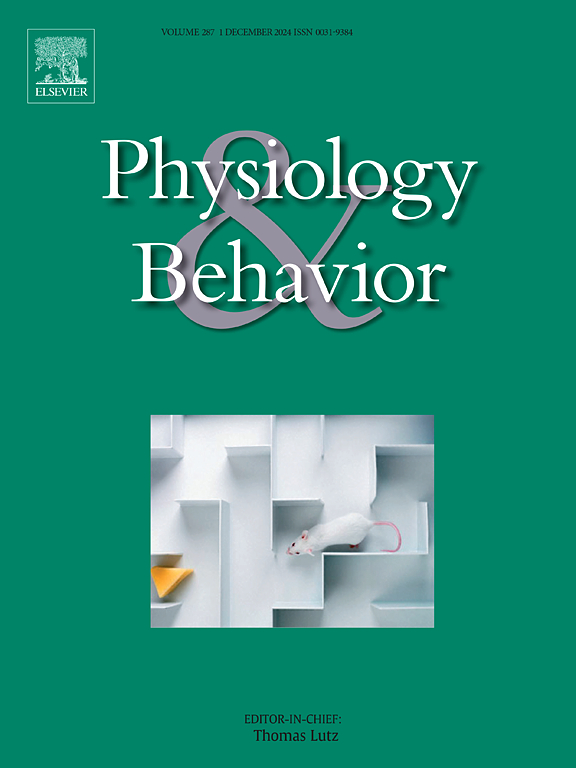Witness stress promotes age and sex-dependent behavioral and neurofunctional alterations in the amygdaloid complex and dorsal hippocampus in mice
IF 2.5
3区 医学
Q2 BEHAVIORAL SCIENCES
引用次数: 0
Abstract
Humans are frequently exposed to stress, with social stress being a predominant factor, either directly experienced or observed. Chronic stress is linked to psychiatric disorders such as depression and anxiety and induces morpho-functional changes in brain areas like the amygdaloid complex and dorsal hippocampus, which influence emotional responses. This study examined the impact of witness social defeat stress (WSDS) on depression-like behaviors and neural activation in Swiss-Webster mice, considering variables like sex and life stage. Two experiments were conducted: Experiment 1 assessed the effects of WSDS in adulthood (58–60 postnatal days [PND]) on behaviors such as coat state, nest building, novel object exploration, and body weight gain, as well as neuronal activation in the amygdaloid complex and dorsal hippocampus. Experiment 2 evaluated the long-term effects of early WSDS exposure (21 PND) on these same parameters, reassessing mice at 58–62 PND. Results showed sex-dependent behavioral changes, including altered novel object interaction, coat and nest quality, and decreased ΔFosB Protein Expression in the amygdaloid complex and hippocampus, with age and sex influencing the stress response. WSDS in adulthood produced smaller behavioral changes, with some signs of resilience particularly in females, while early exposure to this type of stress led to more pronounced effects. This study highlights the complexity of stress responses, suggesting that the intensity and timing of stress, along with sex, play critical roles in shaping behavioral outcomes.
目击者应激促进小鼠杏仁核复合体和背侧海马的年龄和性别依赖性行为和神经功能改变。
人类经常面临压力,社会压力是一个主要因素,或直接体验或观察。慢性压力与抑郁和焦虑等精神疾病有关,并会导致杏仁核复合体和海马背侧等大脑区域的形态功能改变,这些区域会影响情绪反应。本研究考察了目击社会失败压力(WSDS)对Swiss-Webster小鼠抑郁样行为和神经激活的影响,考虑了性别、年龄和生命阶段等变量。实验1评估了成年期(出生后58 ~ 60天)WSDS对大鼠皮毛状态、筑巢、新物体探索、体重增加等行为以及杏仁核复合体和海马背侧神经元激活的影响。实验2评估了早期WSDS暴露(21 PND)对这些相同参数的长期影响,重新评估了58-62 PND的小鼠。结果显示,性别依赖性行为改变,包括新物体相互作用、皮毛和巢质量改变,杏仁核复合体和海马ΔFosB蛋白表达降低,年龄和性别影响应激反应。成年期的WSDS会产生较小的行为变化,尤其是在女性身上,有一些恢复力的迹象,而早期暴露于这种压力会导致更明显的影响。这项研究强调了压力反应的复杂性,表明压力的强度和时间,以及性,在塑造行为结果方面起着关键作用。
本文章由计算机程序翻译,如有差异,请以英文原文为准。
求助全文
约1分钟内获得全文
求助全文
来源期刊

Physiology & Behavior
医学-行为科学
CiteScore
5.70
自引率
3.40%
发文量
274
审稿时长
47 days
期刊介绍:
Physiology & Behavior is aimed at the causal physiological mechanisms of behavior and its modulation by environmental factors. The journal invites original reports in the broad area of behavioral and cognitive neuroscience, in which at least one variable is physiological and the primary emphasis and theoretical context are behavioral. The range of subjects includes behavioral neuroendocrinology, psychoneuroimmunology, learning and memory, ingestion, social behavior, and studies related to the mechanisms of psychopathology. Contemporary reviews and theoretical articles are welcomed and the Editors invite such proposals from interested authors.
 求助内容:
求助内容: 应助结果提醒方式:
应助结果提醒方式:


